6 items found
Page 1 of 1
-
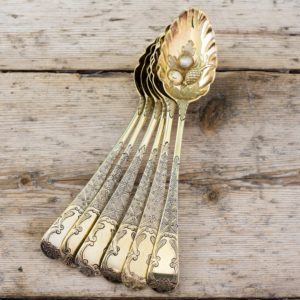
Set of six early nineteenth century silver gilt fruit spoons,
£600 the setSet of six early nineteenth century silver gilt fruit spoons,
Four of the set of six are London stamped, three dated 1811, one dated 1814. The other two stamped Edinburgh dated 1815. Each spoon having shape scoop section with reppouse berry details and engraved decoration to stem.£600 the set -

A set of four sterling silver dinner spoons,
£380 the setA set of four sterling silver dinner spoons,
hallmarked London, dated 1792 in the reign of George III made by Peter Ann Bateman. Each having the addition of bright cut decoration.£380 the set -
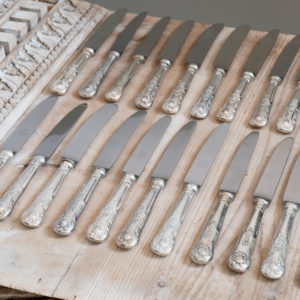
Twentieth century Kings Pattern Cutlery Knives From The Royal Air Force Club,128 Piccadilly London.
£90 A set of sixTwentieth century Kings Pattern Cutlery Knives From The Royal Air Force Club,128 Piccadilly London.
Each knife with stainless steel blade some etched with the Royal Air Force insignia, with handles produced in EPNS (Electro Plated Nickel Silver) using the King's pattern, allegedly made for King George III by far one of the most used and recognisable flatware design in history. Sold in sets of six. The cutlery would have graced the tables at lunches and suppers held at The Royal Air Force Club 128 Piccadilly London.£90 A set of six -
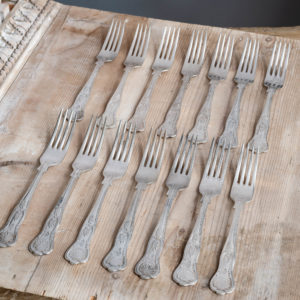
Twentieth century Kings Pattern Forks. From The Royal Air Force Club, 128 Piccadilly London.
£90 a set of sixTwentieth century Kings Pattern Forks. From The Royal Air Force Club, 128 Piccadilly London.
Each fork stamped with the Royal Air Force insignia, produced in EPNS (Electro Plated Nickel Silver) using the Kings pattern, allegedly made for King George III by far one of the most used and recognisable flatware design in history. Sold in sets of six. The cutlery would have graced the tables at lunches and suppers held at The Royal Air Force Club 128 Piccadilly London.£90 a set of six -
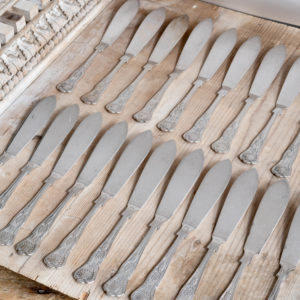
Twentieth century Kings Pattern fish knives from The Royal Air Force Club
£60 a set of sixTwentieth century Kings Pattern fish knives from The Royal Air Force Club
each fish knife stamped with the Royal Air Force insignia, produced in EPNS (Electro Plated Nickel Silver) using the Kings pattern, allegedly made for King George III by far one of the most used and recognisable flatware design in history. Sold in sets of six. The cutlery would have graced the tables at lunches and suppers held at The Royal Air Force Club, 128 Piccadilly, London£60 a set of six -
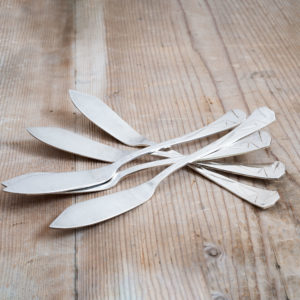
Set of fish knives
£25 the five
Featured Items
-
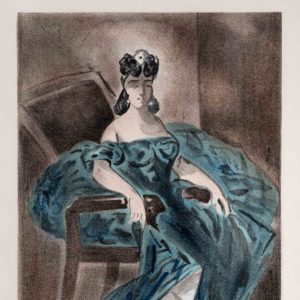
Portraits Part I by Constantin Guys, Verve Vol 2 / No. 5-6.
£500Portraits Part I by Constantin Guys, Verve Vol 2 / No. 5-6.
The Verve Review was a purposefully luxurious. It ran from 1937 to 1960, but with only 38 editions available, due to the high degree of design and editorial work dedicated to each issue. Each edition contained unique lithographic prints, commissioned by the editor, and each cover a double-page lithograph elaborated by one of the artists contained within. It was the brainchild of its editor Stratis Eleftheriades, a Greek National who moved to Paris in the early thirties to take part in the growing Modernist movement, writing under the name of Teriade.£500 -

The Dance, by Henri Matisse, Jan – March 1939 / No. 4.
£1,200The Dance, by Henri Matisse, Jan – March 1939 / No. 4.
The Verve Review was a purposefully luxurious. It ran from 1937 to 1960, but with only 38 editions available, due to the high degree of design and editorial work dedicated to each issue. Each edition contained unique lithographic prints, commissioned by the editor, and each cover a double-page lithograph elaborated by one of the artists contained within. It was the brainchild of its editor Stratis Eleftheriades, a Greek National who moved to Paris in the early thirties to take part in the growing Modernist movement, writing under the name of Teriade.£1,200 -
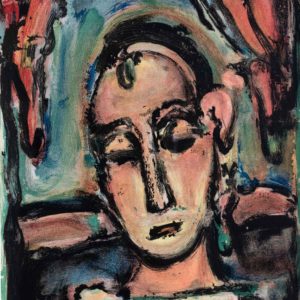
Head of a Girl by George Rouault, Verve Vol 2 / No. 5-6.
£800Head of a Girl by George Rouault, Verve Vol 2 / No. 5-6.
The Verve Review was a purposefully luxurious. It ran from 1937 to 1960, but with only 38 editions available, due to the high degree of design and editorial work dedicated to each issue. Each edition contained unique lithographic prints, commissioned by the editor, and each cover a double-page lithograph elaborated by one of the artists contained within. It was the brainchild of its editor Stratis Eleftheriades, a Greek National who moved to Paris in the early thirties to take part in the growing Modernist movement, writing under the name of Teriade.£800 -
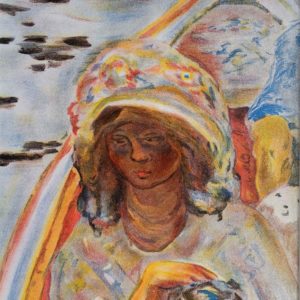
Portrait Fragment by Pierre Bonnard, Verve Vol 2 / No. 5-6.
£600Portrait Fragment by Pierre Bonnard, Verve Vol 2 / No. 5-6.
The Verve Review was a purposefully luxurious. It ran from 1937 to 1960, but with only 38 editions available, due to the high degree of design and editorial work dedicated to each issue. Each edition contained unique lithographic prints, commissioned by the editor, and each cover a double-page lithograph elaborated by one of the artists contained within. It was the brainchild of its editor Stratis Eleftheriades, a Greek National who moved to Paris in the early thirties to take part in the growing Modernist movement, writing under the name of Teriade.£600
